Wait for us, wait for us!
This week: Accidental discoveries; Hidden behind the render; Holiday Thursday; Wiring Complete; Summertime; Looking back;
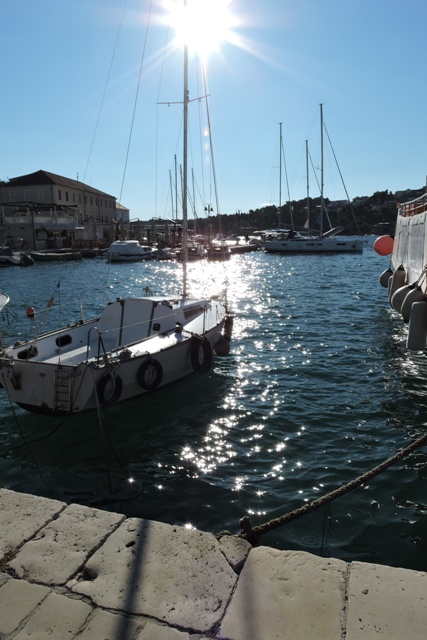
I have been for several walks this week, each time with one or more of the felines. My Senior Cat Callie, sits by the courtyard gate around 6.30 every morning and tells me it’s time for our morning constitutional.
In mid week, with just Callie by my side, I varied our usual route.
This particular morning going towards the deep ravine and the 19th century Austro-Hungarian built dams. Usually we wander through the Olive groves.
We surprised several small snakes which were sunbathing on the stony path. They made off at high speed into the rocky walls which line the paths through the Maquis.
Callie wasn’t the slightest bit interested in the snakes. At 10 years of age, she no longer feels the compunction to chase everything which moves.
By their speed and movement, I suspect they may have been Balkan Whip Snakes, Hierophis gemonensis. Although only in view for fleeting seconds, they appeared to be the right colours.
I was surprised by how overgrown the path has become and how dry the vegetation is. The only thing in flower are the cactus.

So this afternoon, as the temperature eased past 30ºC, I tried to sneak out of the gate to take some photographs. I thought the young felines were asleep and I didn’t want them chasing snakes.
I had barely gone 150 meters up the path when I heard “Mieowwwwww – Wait for us, wait for us!” and round the corner Pongo and Tigger hove into view at a run.
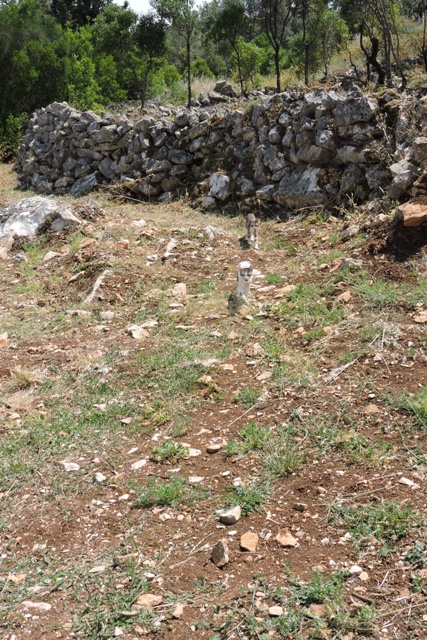
Out of all the kittens, Pongo is especially vocal and hates being left out of things.
I didn’t go as far as I intended and didn’t see any snakes, before we turned round and retraced our steps. The cactus flowers will still be there next week….
Accidental discoveries
Working on the walls of the Konoba on Monday, I was preparing to mix a strong mortar to fix the pattress boxes in place in various holes in the walls.
The walls are as dry as the Gobi Desert. So to stop the mortar setting too quickly, or “going off” as it is known, you need to wet the walls really well first.
Any cement based mixture will crack if it sets too quickly. However by soaking surrounding material it prevents it acting like a sponge, drawing moisture from the mortar.
I bought a new 5 litre pressure sprayer last week, ready to treat the ceiling timbers against insects. I filled it with water, pumped the handle to raise the pressure and sprayed in and around each hole.
What really surprised me was the dust which washed off the stones around each hole. Suddenly the stonework which had been a uniformly cream colour burst into life.
There were the russets and ochres where there are iron ore deposits in the stone, then battleship grey pieces of granite.
Pieces of sandstone were cream coloured and the water dripping onto the floor was coloured by the dust. There are several pieces of what I think may be pink quartz.
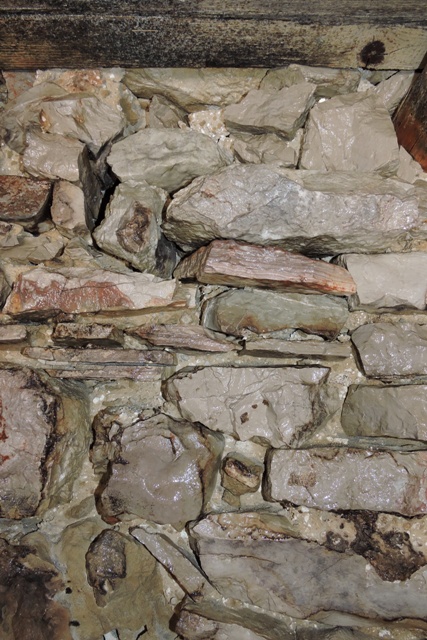
I experimented and extended the area I was spraying.
Starting at the ceiling, then working horizontally, I used a minimum amount of water as a fine spray on each stone.
As the water dripped from the bottom of the stones, it was cream coloured with the dust.
By the time I reached the stones at the base of the wall, drips falling from above had already had an effect, so I needed less spray to clean the stonework.
With low relative humidity and middle of the day temperatures exceeding +30ºC, I was not worried about damp. In fact I was more concerned with keeping the new mortar moist to stop it going off too quickly.
The following morning there was a clear line visible between washed and unwashed. In this photo, the stones on the right have been sprayed and those on the left the are still dusty.
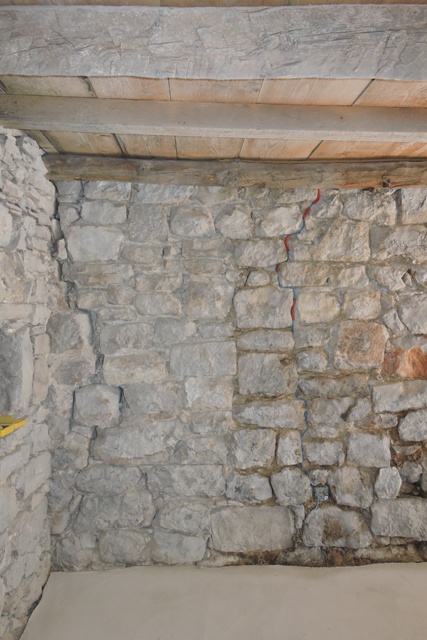
I realised that before the builders come back, I will need to rinse all the walls down. This will bring out the beauty of the stonework without adding to the mess.
Hidden behind the render
One of the difficulties with rendered walls is that you have no idea what is behind the render.
This applies whether the walls are inside or outside. The stonework can be sound, or just a hodge podge of random ashlar.
When I am drilling a rendered wall, it is pure luck whether I hit a stone or a mortar joint. The worst case is where the bit hits the edge of a stone and deflects which causes the drill but to jump.
This usually results in damaged render and loss of patience.
Boring a hole for the cable which will connect the second outside lamp, had to be completed from inside the Konoba. This is to make sure I avoided beams.
I have several 110 cm wall drills of different diameters. These have earned every penny of their keep while I have been here.
With a large and powerful SDS drill, that has a fixed and relatively slow RPM, you plug in the drill bit and keep a gentle back pressure up so the tip of the bit bites into the material.
If the drill bit hits mortar it lurches forward. When it hits a piece of stone, it takes time for the bit to get some purchase on the surface before moving forward again.
Setting the drill up for the lighting cable, it worked its way slowly forward through the 80cm thick wall. Suddenly the pressure eased and the bit was through the wall.
When I looked outside, I had a hole, but the bit had also removed a 30 x 20 cm area of render as well.
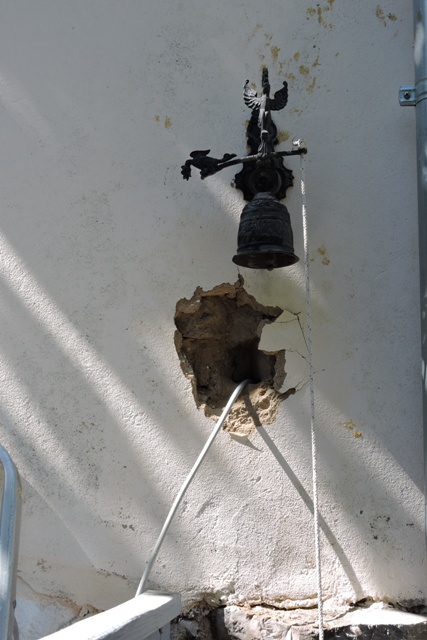
This was not what I had in mind, but I have had it happen more than once before.
Unfortunately the force of the hammer action, over which I have no control, when it reaches an area of weak render will remove a whole chunk.
I know this render has “blown” in several places. Eventually I’ll need to remove all of the material and have the face of the wall re-rendered.
When the time comes I’ll probably use a new silicate material. These new materials are stronger than mortar, on top of a layer of foam insulation.
While I was mortaring in the patress boxes, I also filled in the hole, after thoroughly wetting the wall first. Although the render has failed in several places, it is still keeping the elements at bay.
Holiday Thursday
Here in Croatia there is a confusing mix of legal and religious holidays.
Eight of the days on the calendar are religious holidays and public buildings are closed, but not necessarily shops.
The remaining six days are legal holidays celebrating such things as “Statehood day”.
I’m never sure whether a particular religious holiday is a major or minor holiday, but Thursday was the Feast of Corpus Christi, a Major day.
The bells of St. Michael’s Church began tolling at 7 am and could be heard ringing in celebration, at various intervals until lunch time.
It was a lovely sunny, warm morning, with a gin-clear sky and the felines had been asking to go for a walk.
So I was out, wandering along the path through the Olives while the felines were playing ‘chase’ and generally working off some energy as another peal of bells rang out from the Church.
Meanwhile in the Konoba, after breakfast I started on the task of wiring in the various pattress boxes.
I always feel that when I start the job of connecting the wires up together, it is a sure sign of progress having been made.
At this point I should admit that I have got a little bored with the messy job of letting wires in the Konoba walls.
I have used up my supply of Nivea hand cream, which I use as a barrier cream when I am working with cement, mortar, grout and lime. Even so by lunch time, my hands had lost most of their natural oils.
I have no idea how full time builders manage. Even wearing gloves, and I go through a pair of gloves every fortnight, by the end of the working day, I can’t wait to rub some more cream into my dry skin.
This is just to stop the skin cracking and becoming sore.
All these cables in the walls will be covered with pointing mortar. Even so, I like to leave neat work. However with the three core cable, which is solid rather than stranded copper, there are places where I have to use wire twists to keep the cables in place.
Flex which is always found attached between the plug that goes in the wall socket and an appliance is made up of stranded copper wires. The stranded core has a diameter appropriate for the amount of current an appliance will use.
Cable because it must carry a higher electrical load is made of a solid piece of copper wire, often 2.5 mm in diameter, which makes the cable stiff and difficult to bend.
For this reason, where ever possible, I have run the cable behind the stones, just to hold it firmly in place.
An added complication is that because the upper and lower rooms in this building are all on a single MCB and ring main, I have been using “Chocolate Block” connectors to join the wires in the circuit.
These are temporary connections until I get the parts I need for the face plates on the pattress boxes.
I did an audit of my supplies, which because of COVID have run very low. I don’t have enough of anything in my stock box to finish the Konoba wiring.
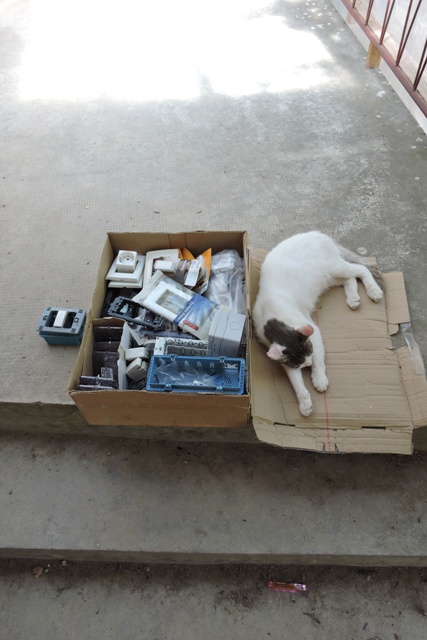
Until the pointing has been done, which is in itself a messy job, I can’t connect up the face plates in any case.
So in the meantime I am just covering the pattress boxes with tape, even though the circuit is now complete and live.
Wiring complete
I’m not keen on letting wires into walls because of the amount of dust that the work creates.
Whether it is a plastered wall or as in the Konoba at the moment, a stone wall with lime mortar, the dust which cutting generates just seems to get everywhere.
Although past the time when shorts are de rigour for working in the heat, I have been wearing my Site contractors trousers all week.
The reasons are firstly, because there is quite a bit of kneeling and the trousers have pockets for knee pads, and secondly so that at the end of each day, I can just shake them to get rid of all the dust.
It takes around a full day to neatly let a cable into the wall. More time is needed to route wires for lights in the wall niches.
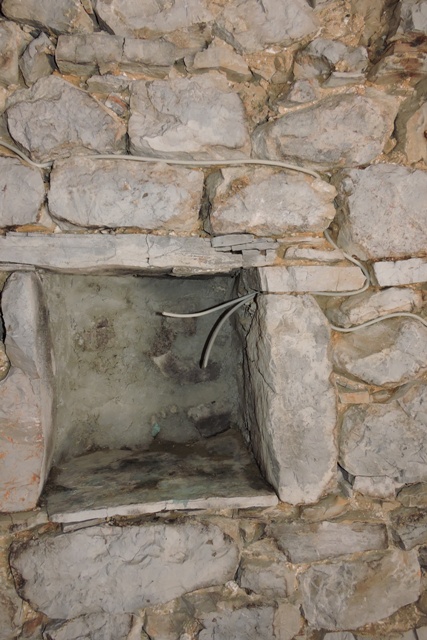
Whether it is planning the route the cable will take, removing mortar from between stones, or feeding the cable through gaps and between stones, it all takes time.
Removing pieces of stone to fit the pattress boxes has to be done with care. Even being super carefull with the electric tools can still result in a whole stone coming away in your hand.

As the machine vibrates, so the wall vibrates in sympathy and you see small rivulets of sand and mortar appearing up to a metre away from where you are working.
I think I will need to have the wall stabilised once the pointing has been finished, because there are clearly some large voids behind the stone façade.
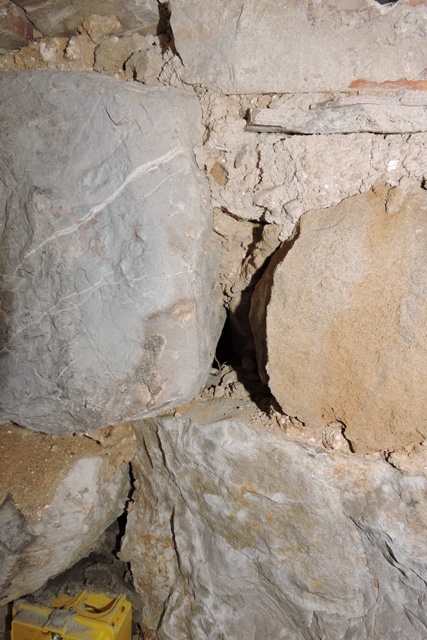
By Saturday I had finished, with all the pattress boxes in place in the walls, the wires routed and the ring main complete.
So now all I am ready for the builder to return next week and do the pointing.
Summertime
After a very cool spring, much like the rest of Europe, we have now lurched into normal summer temperatures.
I’ve heard locals this week complaining about the heat! The weather always gives people something to talk and complain about, where ever in the world you live.
One of my summer flowering plants is the Peruvian Lily, the Alstoemeria.
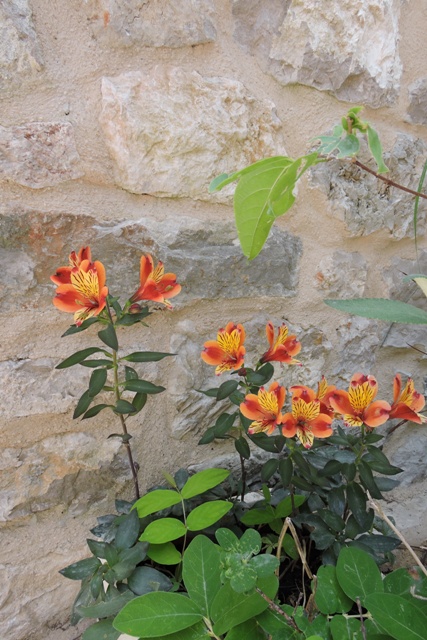
I have a couple of different coloured varieties, both of which seem to have adapted to the conditions here in Dol. They are from the summer growing and flowering Brazilian family.
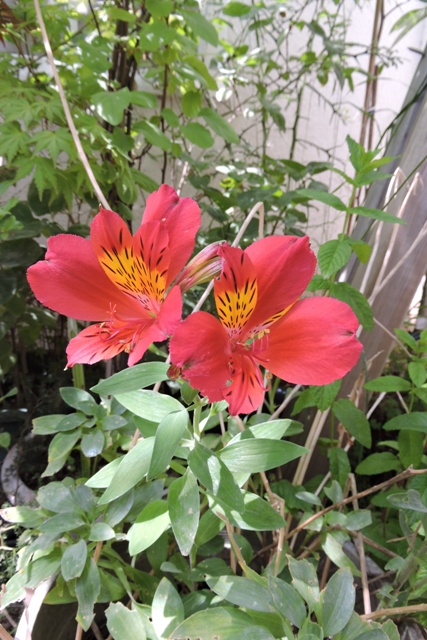
The Chilean variety are winter flowering and I would like to try and find some seed to try and grow here.
One flowering tree in evidence everywhere at the moment is the Pomegranate. They grow wild along side roads and paths and in hedgerows as well as the two I have in my orchard.
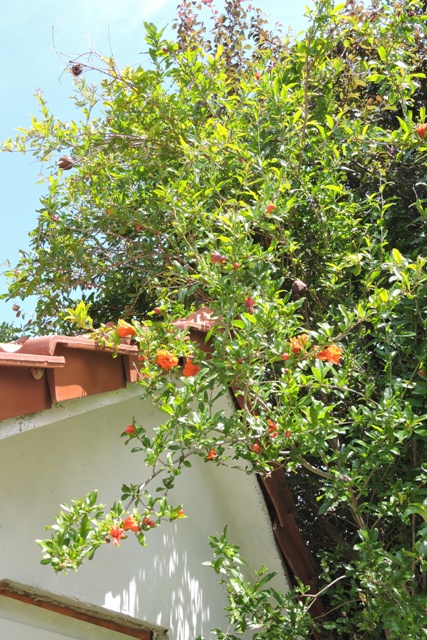
Each bright red flower will by autumn have become a plump, russet coloured fruit.
A favourite shrub of mine at this time of year is the Lantana, Lantana camara. They are a food source for bees, butterflies and moths from the moment they begin to flower in the spring, until they finish in November.
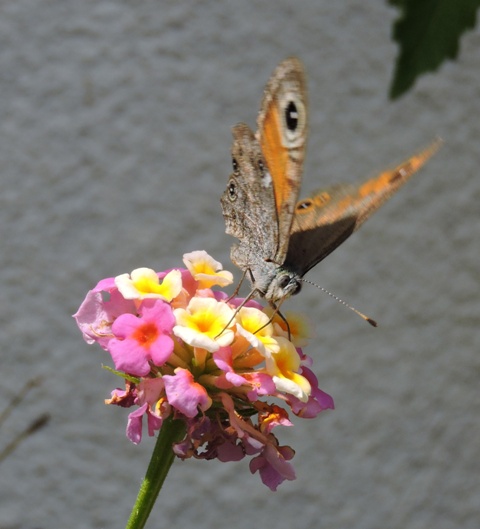
At the moment the first hatching of Wall Browns, Lasiommata megera, are flying and feeding on my Lantana. Soon it will be visited by a multitude of different butterflies and moths, at all times of the day and night. NCG
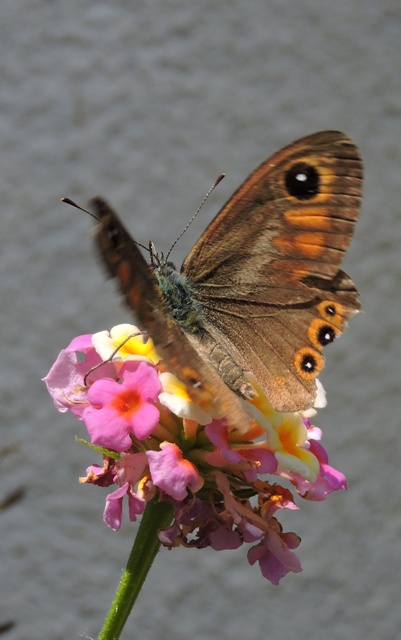
Looking back – Week 22
This is the start of a new weekly section, with links to past issues of the blog.
2015/22 A bore in the garden?

2016/22 Teacher to the rescue!
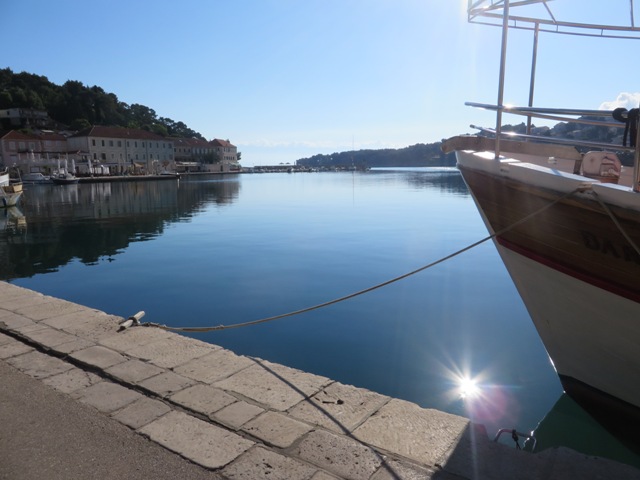
2017/22 It’s just a little injection. It won’t hurt at all…

2018/22 Technology is not the panacea
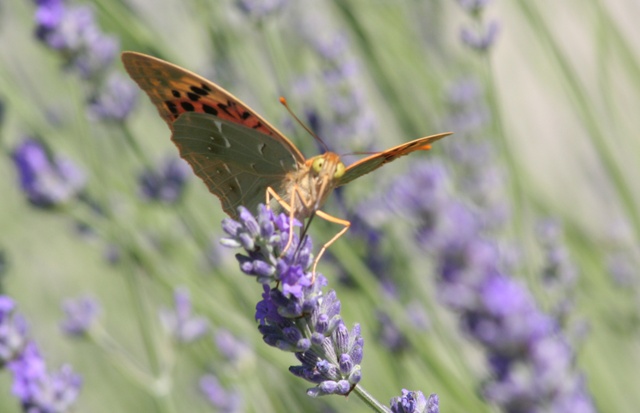
2019/22 The end of May
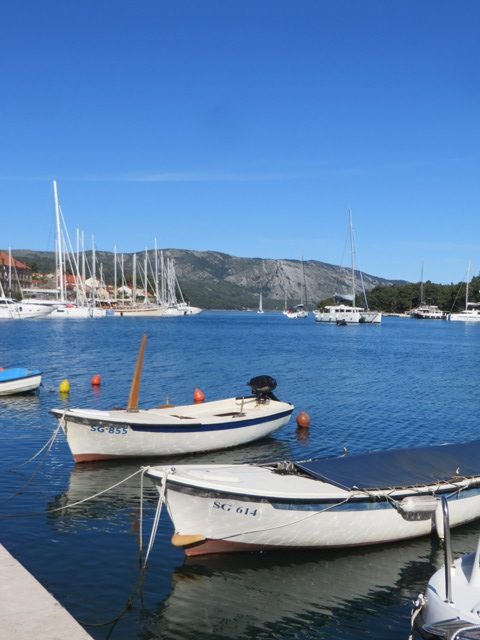
2020/22 We’re on Cannabis
